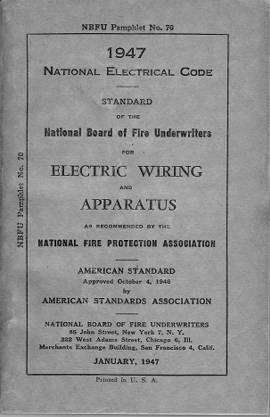Grounded Conductor to be Identified
By L.W. Brittian

Reading the 6 Th. Edition of the National Electrical Code Handbook, based upon the 1947 NE code supplement, It talks about existing wiring and the grounding conductor not being identified. That the code is not retroactive. That with the new edition of the NE code they must to be identified as white or natural gray. So the color white has been required to be used for over 60 years to identify the grounded conductor!
Chapter 19 GROUNDING, identifies two types of grounding:
"A system ground is a connection to ground from one of the current carrying conductors of a distribution system or an interior wiring system "
"An equipment ground is a connection to ground from one or more of the non-current carrying metal parts of the wiring system or of apparatus connected to the system. As used in this sense, the term equipment includes all such metal parts such as metal conduit, metal raceway, armor of cables, outlet boxes, cabinets, switch boxes, motor frames and metal enclosures of motor controllers."
The general descriptions provided in this edition of the handbook for why systems are ground follow the concepts specified in the NEC today.
The word "bonding" is not used even once in the entire chapter covering grounding.
The system diagrams provided in the Grounding chapter show metal conduit connected to the grounded service enclosure. No EGC is shown!
Yet another quote is:
" It is recommended that in locations where it is necessary to use burred or driven electrodes for grounding interior wiring systems, additional grounds such as connections to a system grounding conductor, be placed on the distribution circuit."
I understand this to be an early recommendation for what today we call an equipment grounding conductor (EGC).
Deeper in the grounding chapter, I found the following quote to be interesting:
" The resistance of a good ground to a water piping system will commonly be much less that 2 ohms, with corresponding reduction in the possible voltage to ground where heavy current flows through ground connections."
" A single rod or pipe driven 8 ft in the ground does not, as a general rule, provide as low a ground resistance as is desirable, particularly where the soil at times becomes very dry or where rock underlies a large area."
Perhaps this is why there is a modern code requirement that a ground with more than 25 ohms be supplemented.
The handbook shows two pictures of a "Groundmeter" what I call a three point fall of potential test instrument, a Weatstone bridge or a kelvin meter.
Another interesting quote follows:
" Continuous metallic underground water- or- gas-piping systems in general have a resistance to ground of less than 3 ohms. Metal frames of buildings and local metallic underground piping systems, water well casings, and the like, have, in general, resistance substantially below 25 ohms."
From this reference to 25 ohms, I infer a general agreement in industry at that time, that a ground of over 25 ohms would prove to be ineffective. I have yet to discover the original source of and science supporting the 25 ohm value referenced in today's NE code.
The chapter covering Hazardous locations requires a bonding jumper be used and not lock nuts. So the current NE code requirement to use a bonding jumper in hazardous (classified) locations has been around for over sixty years.
During this stage of development of electrical systems and equipment, three prong 110 volt plugs were known, however most convenience outlets and appliances were provided with only two prong plugs.
The author of this edition of the McGraw-Hill National Electrical code Handbooks is the Arthur L Abbot of New York, NY.
Gee I wish I could talk with Mr. Abbot, and Mr.Edison, Bell, Tesla, Westinghouse, Mr. Croft, Mr. Summers, Mr. Soares. . .
"History is the tutor of life"
L.W. Brittian
Mechanical and Electrical Instructor